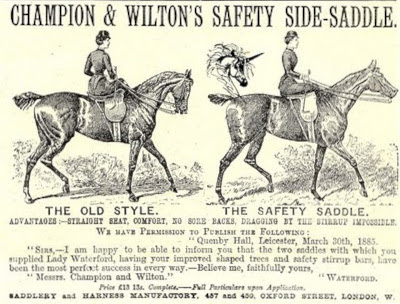Introduction: Ladies in the saddle
On a crisp Victorian morning, a young noblewoman canters through Hyde Park, side-saddle atop a gleaming hunter. Her posture is graceful and secure, long skirt draped elegantly over one side of the horse. Such a scene – a woman riding aside with poise – was made possible by centuries of innovation in saddle design and shifting social norms. Central to this story is Champion & Wilton, a renowned London saddlery whose masterful design and craftsmanship helped refine the side-saddle into an icon of 19th-century equestrian fashion and culture.

Origins of the side-saddle: Decorum meets design
For much of history, women’s horseback riding was constrained by fashion and ideas of modesty. In medieval Europe, women typically rode as passengers behind men, perched on a pillion or small padded seat, because riding astride in long skirts was impractical and socially unacceptable.
Early side-saddles resembled a chair, with the lady sitting sideways, feet on a footrest. It was decorative rather than functional, offering little control over the horse. Over time, designers introduced forward-facing positions and added pommels that enabled better balance and some degree of control.
One major shift came in the 16th century with the introduction of a single pommel allowing the rider to hook her right leg, enabling a forward-facing position. This allowed for modest movement and greater command of the horse, while still maintaining the decorum expected of women.
A revolutionary leap: The 19th-Ccentury side-saddle evolves
It wasn’t until the early 1800s that the side-saddle was transformed into a truly practical and secure riding option. The introduction of the second pommel – the leaping head – in the 1830s marked a turning point. This addition secured the rider’s left thigh and enabled women to ride at a full gallop and even jump fences.
By the Victorian era, riding side-saddle had become a symbol of grace, control, and femininity. It was a rite of passage for women in high society. Now, with the right saddle, a lady could participate in hunts, parades, and even horse shows without compromising modesty or safety.
Champion & Wilton: Master saddlers of Victorian England

During this period, Champion & Wilton rose to prominence as the leading makers of side-saddles in Britain. Founded in the late 18th century, the firm became synonymous with elite craftsmanship. Located on Oxford Street in London, their workshop produced bespoke saddles for British royalty, nobility, and accomplished horsewomen.
Champion & Wilton earned Royal Warrants from multiple monarchs and supplied saddles to queens and emperors across Europe. At their peak, their workshop employed over a hundred skilled saddlers. They were known not only for their elegant construction but for their constant innovation.
Innovation in design: Safety and comfort
Henry Staines Wilton, a key figure in the company’s history, was an inventor as much as a saddler. In 1879, he patented a quick-release safety stirrup bar that prevented riders from being dragged if they fell. This invention became standard in side-saddle design.
He also developed improvements in pommel shape, saddle trees, and seat balance. Their “straight-seat” saddles were praised for providing greater comfort for riders and distributing weight more evenly on the horse. Champion & Wilton’s designs balanced aesthetics, safety, and performance like no other maker of their time.
Craftsmanship and aesthetics: The ar of the side-saddle
Every Champion & Wilton saddle was custom-made, tailored to both horse and rider. They were crafted from fine leather, often in a rich chestnut hue. Their signature style included unique details like an oblong stirrup cover and hidden storage pockets.
Later models featured wider, flatter pommels for better support and inlaid seats for visual flair. Their saddles were built not only to function flawlessly but to embody beauty, elegance, and the prestige of their owners. Many of these saddles survive today and are still used in riding exhibitions and shows.
Fashion and equestrian culture: An elegant partnership
The side-saddle became more than a tool; it was a symbol of status, skill, and femininity. As women embraced more active roles in equestrian culture, they required gear that could match their ambitions. Champion & Wilton provided that foundation.
The evolution of riding attire – from heavy skirts to split aprons and tailored habits – went hand-in-hand with saddle innovation. Together, they allowed women to be bold, stylish, and safe in the saddle.
High-profile figures like Queen Alexandra helped popularize this elegant image. When these women rode side-saddle in public, they inspired admiration and emulation across the social spectrum.
Legacy of Champion & Wilton and the side-saddle tradition
Though side-saddle riding declined in the 20th century, the tradition endures among enthusiasts, competitors, and collectors. Champion & Wilton, absorbed by another company in 1961, left behind a lasting legacy of craftsmanship and innovation.
Today, their saddles remain benchmarks of quality. Restored Champion & Wilton side-saddles are sought-after for both their functionality and their historical value. They represent not just an elegant way of riding, but a cultural moment where design empowered women to ride with freedom and style.
Champion & Wilton helped make the side-saddle a masterpiece of both engineering and art – a true symbol of equestrian heritage that still captures the imagination.

Comments are closed